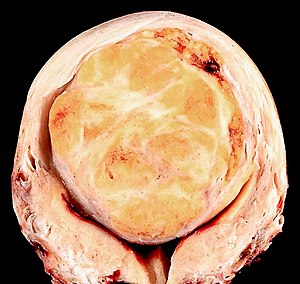Hysterectomy for fibroids grossing
This protocol a protocol for grossing a hysterectomy for fibroids, also hysterectomy for leiomyomas.
It also covers grossing a hysterectomy for benign disease.
Introduction
This is a very common surgery. It said that approximately 40% of forty year old have fibroids. Other indications for hysterectomy are: dysfunctional uterine bleeding and hemorrhage (postpartum).
Unexpected malignancies (based on a series of 6,360 cases) are seen in approximately 2.7% of cases and include (1) endometrial carcinoma (1.02% of cases), (2) cancers of the tube, ovary and peritoneum (1.08% of cases), (3) uterine sarcoma (0.22% of cases), (4) metastatic disease (0.20% of cases) and (5) cervical cancer (0.17% of cases).[1]
Protocol
Specimen type: total hysterectomy.
Dimensions:
- Uterus and cervix: ___x___x___cm, ____grams.
- Left ovary: ___x___x___cm.
- Left fallopian tube: length ___ cm, diameter ___cm.
- Right ovary: ___x___x___cm.
- Right fallopian tube: length ___ cm, diameter ____cm.
- Exocervix: diameter ___ cm.
Appearance:
- Uterine shape: pear-shaped/distorted.
- Serosal surface: smooth shiny.
- Serosa lesions: none/nodules up to ___cm in greatest dimension.
- Ectocervix: tan-white glistening with a probe patent os.
Internal dimensions:
- Endometrial cavity: ___x___cm.
- Endometrium: thickness ___cm.
- Maximal myometrial wall thickness: ___cm.
- Endocervical canal: length ___ cm, diameter ___ cm.
Internal/additional appearance:
- Left ovary: unremarkable.
- Left fallopian tube: unremarkable.
- Right ovary: unremarkable.
- Right fallopian tube: unremarkable.
Tumour(s):
- Appearance and location: intramural and subserosal white, firm, and whorled circumscribed/ill defined nodules.
- Number of tumors: ___.
- Size: range ___to ___cm in greatest dimension.
- Hemorrhage: present in ___ % of tumor / absent.
- Necrosis: present in ___ % of tumor / absent.
- Calcification: present / absent.
Additional findings: ___.
SECTION CODE:
- Anterior cervix and lower uterine segment
- Posterior cervix and lower uterine segment
- Posterior endomyometrium, full thickness
- Right ovary and , right fallopian tube [fimbria submitted entirely], with paratubal cysts
- Left ovary and left fallopian tube [fimbria submitted entirely]
- Submit sections of fibroids as per protocol (see next page).
Protocol notes
Blocking protocol
Submit sections of fibroid as follows:
- Any suspicious areas of gross hemorrhage/ necrosis and softer consistency must be sampled.
- Any single fibroid >5 cm --> put one section per 2 cm, with put up to 2 sections per cassette.
- Any single fibroid >1 cm to up to 5 cm --> put one section per lesion
- Fibroids <=1 cm, and multiple in number --> use no more than five cassettes, each cassette can contain sections from two distinct fibroids.
- Any single fibroid >10 cm, please review the specimen with the attending pathologist.
Examples:
- 5.5 cm = 3 sections.
- 6 cm = 3 sections.
- 8 cm = 4 sections.
- 8 fibroids, all less than 1 cm = 4 cassettes, 2 sections per cassette.
- 15 fibroids = 5 cassettes, sample ten individual fibroids.
Alternate approaches
Also submit:
- Anterior endomyometrium, full thickness.
Do not submit:
- Posterior endomyometrium, full thickness.
See also
Related protocols
References
- ↑ Mahnert, N.; Morgan, D.; Campbell, D.; Johnston, C.; As-Sanie, S. (Feb 2015). "Unexpected gynecologic malignancy diagnosed after hysterectomy performed for benign indications.". Obstet Gynecol 125 (2): 397-405. doi:10.1097/AOG.0000000000000642. PMID 25569001.
